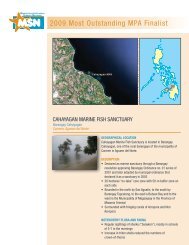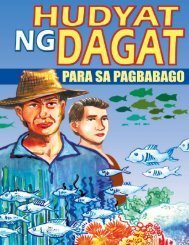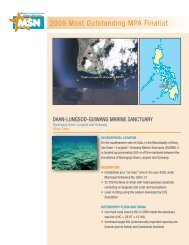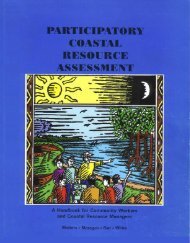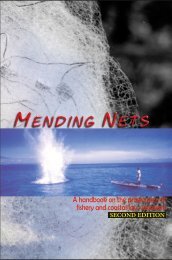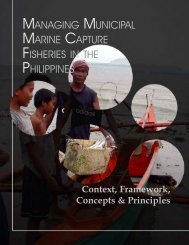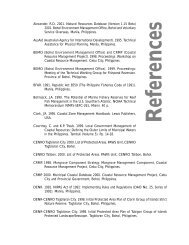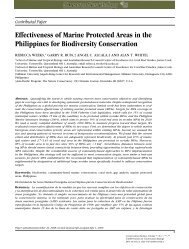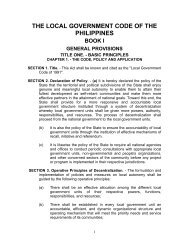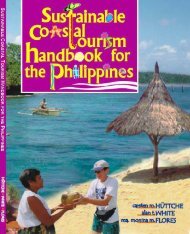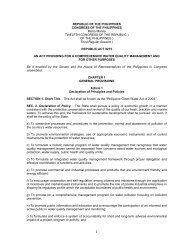3.9MB / Click here to download - Oneocean.org
3.9MB / Click here to download - Oneocean.org
3.9MB / Click here to download - Oneocean.org
You also want an ePaper? Increase the reach of your titles
YUMPU automatically turns print PDFs into web optimized ePapers that Google loves.
20 Rhythm of the Sea<br />
The only large preda<strong>to</strong>ry species observed was Lutjanus decussatus of the family<br />
Lutjanidae (snapper). Its density was very low (less than 1 per 500 m 2 ), which indicates<br />
extreme overfishing in the area. These large preda<strong>to</strong>ry fish are highly priced, and vulnerable<br />
<strong>to</strong> various fishing gears including hook and line, traps and spearfishing. Because of this,<br />
they are regarded as good indica<strong>to</strong>rs of fishing pressure on coral reefs.<br />
Other fish desired by fisherfolk include 24 target species, most of which are reefassociated.<br />
The average biomass, as estimated by SUML, of these target species was<br />
203.32 g. The highest biomass (524.86 g) was found off Inabanga, which had the highest<br />
percentage of coral cover in the profile area. On the other hand, Getafe had the lowest<br />
biomass (15 g), as well as the lowest species richness and density of reef-associated fish.<br />
It should also be noted that Getafe has a relatively low coral cover. This limited incidence<br />
out of 24 target species is troubling, because it means that almost all of the target species<br />
are missing, which is yet another indica<strong>to</strong>r of overfishing in the area. This number of target<br />
species is very low compared <strong>to</strong> healthy coral reefs not being overfished.<br />
The absence of other large preda<strong>to</strong>rs, such as families of grouper (Serranidae),<br />
bream (Lethrinidae) and jacks (Carangidae) may be due <strong>to</strong> the reputedly rampant illegal<br />
fishing. Dynamite and cyanide fishing is still prevalent in the whole profile area, with<br />
residents of Getafe and Calape reporting dynamite blasts of up <strong>to</strong> 18 per day. This method<br />
of fishing takes advantage of high fish density, but harms the relatively high coral cover<br />
found t<strong>here</strong>. The use of trawls which drag on the substrate is another destructive fishing<br />
method which is very efficient and contributes <strong>to</strong> the overall degradation of habitat and<br />
lowering in fish s<strong>to</strong>ck.<br />
During test-fishing (gill net) surveys by SUML, most of the species of fish measured<br />
less than their respective commonly-caught sizes. They were also shorter than their<br />
respective maximum lengths. This is another indication of intense fishing pressure in the<br />
area, w<strong>here</strong> even the small, young fish are captured. While this may provide a current<br />
source of food and market income, it threatens <strong>to</strong> lower fish catch (and human welfare) in<br />
the future. Even now, the small fish sold in the market command low prices, which is<br />
beginning <strong>to</strong> disrupt local income patterns. Catching young fish is very inefficient. It wastes<br />
the fish and disallows them from spawning <strong>to</strong> produce the next generation.<br />
Results of Par<br />
articipa<br />
ticipa<strong>to</strong>r<br />
<strong>to</strong>ry y Coastal Resource<br />
ce Assessment (PCRA)<br />
The results of barangay and municipal level PCRAs in 1997 and 1998 for the 7 municipalities<br />
from Loon <strong>to</strong> Getafe are presented in Figures 3.1 <strong>to</strong> 3.8. Important habitats are mapped as<br />
well as resources, uses and issues. It is noted that coral reefs and seagrass beds are<br />
dominant features of this coastline. The resources and their uses are similar throughout<br />
the 7 municipalities. Management issues persist with major concerns being overfishing,<br />
use of destructive methods, poor law enforcement and others as noted. The maps in<br />
Figures 3.1 <strong>to</strong> 3.8 can serve as a baseline for habitat management in the area and are<br />
generated by a geographic information system (GIS) for future updates and use.



